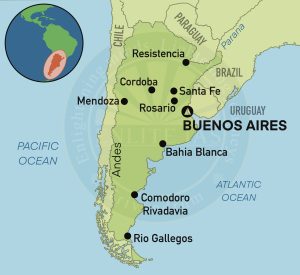- A groundbreaking expedition to Argentina’s Mar del Plata Canyon uncovered over 40 potential new deep-sea species, including glass squids and pink lobsters.
- Location: Argentina is a South American country.
- Capital: Buenos Aires
- Fact: The second-largest country in South America after Brazil.
- Bordering Countries: Chile, Bolivia, Paraguay, Brazil, Uruguay.
- Bordering Waterbodies: South Atlantic Ocean, Drake Passage.
- Disputed Territory: Falkland Islands with Britain
- Climate: Temperate Climate
- Local Wind: Pampero Winds
- Desert: Patagonia
- Grasslands: Pampas
- Economic Significance: Part of Lithium Triangle.

Mar del Plata Canyon
- Location:
- Situated along the continental margin off the coast of Buenos Aires Province, Argentina.
- Lies about 250–300 km offshore from the city of Mar del Plata in the South-Western Atlantic Ocean.
- It is one of the largest submarine canyons on the Argentine continental margin system.
- Geological & Oceanographic Features:
- Type: Submarine canyon — a deep, steep-sided valley incised into the continental slope and rise.
- Depth: Reaches approximately 3,000–3,500 metres below sea level, extending from the continental shelf to the deep Atlantic basin.
- Seafloor Composition: Dominated by fine sand mixed with terrigenous material (land-derived sediments) and planktonic foraminifera substrate (microfossil deposits).
- Formation: Shaped by turbidity currents, sediment erosion, and underwater landslides transporting material downslope.
- Hydrographic Characteristics:
- The region is highly productive, influenced by the Argentine Shelf-break Front, a permanent oceanographic front marking a sharp boundary between contrasting water masses:
- Sub-Antarctic shelf waters (cold, nutrient-rich), and
- Cooler, more saline waters of the Falkland-Malvinas Current.
- This interaction creates a thermohaline front (temperature-salinity gradient), leading to nutrient upwelling, high plankton productivity, and rich marine biodiversity.
- The region is highly productive, influenced by the Argentine Shelf-break Front, a permanent oceanographic front marking a sharp boundary between contrasting water masses:
